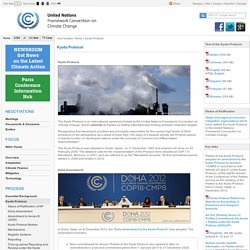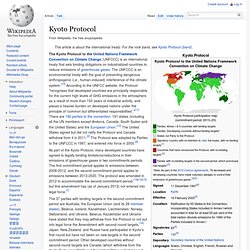

Clean Development Mechanism. Certified emission reduction units (CERs) monthly spot prices 2012 The Clean Development Mechanism (CDM) is one of the flexibility mechanisms defined in the Kyoto Protocol (IPCC, 2007) that provides for emissions reduction projects which generate Certified Emission Reduction units which may be traded in emissions trading schemes.[1] The CDM is defined in Article 12 of the Protocol, and is intended to meet two objectives: (1) to assist parties not included in Annex I in achieving sustainable development and in contributing to the ultimate objective of the United Nations Framework Convention on Climate Change (UNFCCC), which is to prevent dangerous climate change; and (2) to assist parties included in Annex I in achieving compliance with their quantified emission limitation and reduction commitments (greenhouse gas (GHG) emission caps).[2] "Annex I" parties are those countries that are listed in Annex I of the treaty, and are the industrialized countries.
History[edit] Purpose[edit] Blogs: Doug Craig's blog. Kyoto Protocol. The Kyoto mechanisms Under the Protocol, countries must meet their targets primarily through national measures.

However, the Protocol also offers them an additional means to meet their targets by way of three market-based mechanisms. The Kyoto mechanisms are: The mechanisms help to stimulate green investment and help Parties meet their emission targets in a cost-effective way. Monitoring emission targets Under the Protocol, countries' actual emissions have to be monitored and precise records have to be kept of the trades carried out. Registry systems track and record transactions by Parties under the mechanisms. United Nations Framework Convention on Climate Change.
The Kyoto Climate Control Protocol. Climate Change and the Kyoto Protocol. Introduction Over the past decade, as the evidence of climate change became clearer and better understood, a strong international movement for action has emerged. In 1992 at Rio de Janeiro, more than 180 countries signed the United Nations Framework Convention on Climate Change, which outlined the need to reduce greenhouse gas emissions as a global response to climate change. The UNFCCC came into effect in March, 1994, but despite this establishment, very little action was taken around the world. 27 The Kyoto Protocol; which was agreed upon on December 11, 1997, at a meeting of the UNFCCC in Kyoto, Japan; was created as an effort to force action on the international community. 28 Overview of the Kyoto Protocol Under the Kyoto Protocol, industrialized nations agreed to cut their greenhouse gas emissions to a certain percentage below 1990 levels.
The Kyoto Protocol applies to industrialized nations only. Text of the Kyoto Protocol Reduction Targets and Ratification Status What If...? Kyoto Protocol. Kyoto Parties with first period (2008–12) greenhouse gas emissions limitations targets, and the percentage change in their carbon dioxide emissions from fuel combustion between 1990 and 2009.

For more detailed country/region information, see Kyoto Protocol and government action. Overview map of states committed to greenhouse gas (GHG) limitations in the first Kyoto Protocol period (2008–12):[8] Dark grey = Annex I Parties who have agreed to reduce their GHG emissions below their individual base year levels (see definition in this article) Grey = Annex I Parties who have agreed to cap their GHG emissions at their base year levels Pale grey = Non-Annex I Parties who are not obligated by caps or Annex I Parties with an emissions cap that allows their emissions to expand above their base year levels or countries that have not ratified the Kyoto Protocol The European Union as a whole has in accordance with the Kyoto Protocol committed itself to an 8% reduction.
Background[edit] Asia[edit]